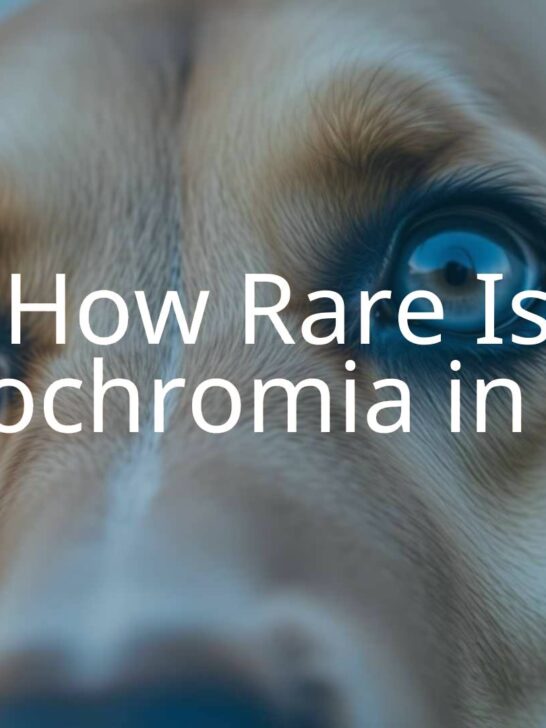The Ultimate Breed Guide to Liver German Shepherds
When you think of a German Shepherd, you’re most likely to picture the classic black and tan dog that is one of the most popular breeds in America.
However, you’re not likely to immediately think of one of the rarest types of German Shepherds:
The Liver German Shepherd.
Liver German Shepherds are a unique and unusual type of German Shepherd.
These dogs feature a diluted light brown coat that is caused by a recessive gene.
Despite their difference in coat color, Liver German Shepherds exhibit all the same characteristics as a standard German Shepherd.
If you’re looking to own a Liver German Shepherd or if you’re merely curious about the breed, you’ve come to the right place.
We have researched how the coat of these dogs appears, their temperament, and whether you should get one.
Here is the ultimate breed guide to Liver German Shepherds!

What is a Liver German Shepherd?
A Liver German Shepherd is no different from a standard black-and-tan German Shepherd – except the coat is a liver color.
This color is usually a light brown that can often come with combinations of tan or white.
The eyes and nose of a Liver German Shepherd are also fairly different from a regular German Shepherd.
Their noses are usually brown or pink compared to a black nose, and the eyes are generally a lighter amber than dark brown.
Liver German Shepherds are notorious for their year-round shedding coat.
This is because they have a double-layer coat, with a wiry protective coat on top and an insulation coat underneath.
Liver German Shepherds have a life expectancy of 9 to 13 years.
Both male and female Liver Shepherds can grow up to 24” tall and weigh an average of 30-40 kg and 20-32 kg respectively.
Breed History
As the name suggests, German Shepherds originated in Germany in the late 1800s.
The aim was to breed dogs that could herd sheep and protect flocks.
Shepherds in Germany worked to create breeds that had the characteristics of intelligence, strength, speed, and a high sense of smell.
A society was formed in Germany called the Phylax Society, which was formed to promote and create standardized breeds.
Due to conflicts in the society, it only lasted 3 years.
In 1899, however, the first bred German Shepherd was discovered at a dog show by an ex-member of the Phylax Society – Max von Stephanitz.
The breeding of this dog became the starting point for the popularity of German Shepherds as their physique and characteristics were ideal for protecting and herding sheep.
German Shepherds have since become one of the most popular breeds of dogs across the world.
They have developed other kinds of coat colors, including white, black, blue, panda, and liver.

What causes a Liver German Shepherd’s coat color?
The reason why a Liver German Shepherd gets its namesake coat color is because of a recessive gene.
Both German Shepherd parents need to carry at least one liver gene for the puppy to develop a liver coat.
The parents don’t have to be liver-colored themselves as long as they both carry the recessive B Locus gene in their genetic material.
A mutation in the B Locus gene is responsible for the brown or liver coloring in a dog’s coat, nose, and footpads.
There are three mutations of this gene, all of which affect the pigmentation of black or dark brown fur.
For a German Shepherd to have a liver-colored coat, it must receive two copies of any of the three B Locus gene mutations.
This will prevent any black strands of hair (or black feet pads or noses) from appearing on the German Shepherd, giving it its distinctive liver coloring and light appearance due to limited pigmentation.
It is impossible for a Liver German Shepherd to have both liver and black strands in their body.
This is because the B Locus gene suppresses eumelanin pigmentation, which is black or dark brown pigment.
A dog without the B Locus gene will have eumelanin skin that makes its coat appear black. A dog with the B Locus gene will have a light brown coat.
The same thing happens for Blue German Shepherds, who inherit genes that prevent black pigmentation.
This is what causes the diluted, “blue” fur appearance.
Here’s where it gets a bit more complicated.
When a dog has two copies of the B Locus gene, its coat is said to be reddish-brown.
This is why some Liver German Shepherds are often referred to as Red German Shepherds.
The second gene from the two copies will determine the color variation for the Liver German Shepherd.
This will dictate whether the dog has a solid coat color, or whether it has a distribution of other colors.
The different coat patterns for German Shepherds include:
- Solid liver (where the dog’s coat is only one color)
- Saddleback pattern (where a second color cover the whole back of the dog like a saddle)
- Blanket back pattern (where the second color covers the majority of the dog’s back and legs like a blanket)
- Panda pattern (where the second color is dispersed across the coat randomly like a Panda bear)
- Bi-color pattern (where there is predominantly one color and then a second is limited across the body)
- Sable pattern (where the liver patches are distributed amongst blotches of lighter or darker tan or brown colors)
Liver German Shepherds are most likely to either have a solid pattern, a sable pattern, or potentially a panda pattern.
However, remember that it is genetically impossible for a Liver German Shepherd to have black strands, so any other color variations are likely to only be a slightly darker or lighter brown (known as tan).

Puppies vs. Adults
As puppies, Liver German Shepherds have a lighter color all around until they develop more pigmentation as they age.
Their coat is a pale liver color all over, and their paws and toes are pale pinks. Their nose is a light pink, and their toenails are white.
Plus, their eyes are usually a pale green or blue color.
As they age, Liver German Shepherds begin to develop more pigmentation in their coats, skin, and eyes.
The coats might develop different shades amongst the liver, which cannot be controlled.
Their feet and noses will darken slightly into a liver color, so they are basically the same color all over.
As for their eyes, the color will darken into a brown shade at around six months old.
If your Liver German Shepherd has a bi-color pattern, its coat can change shades and patterns for the first two years of its life.
After these years, the color will stop developing and will remain as it is.
As for the size of Liver German Shepherd puppies, they grow very quickly from a young age.
After two weeks of being born, they will double in size and tend to weigh around 8.5 kg.
During the first year, the puppy will continue to gain 10% in size per month.
They are said to stop growing and reach maturity at 2 years, which is also when the color of their coat stops developing.
Are Liver German Shepherds rare?
Liver German Shepherds are perhaps the rarest color of German Shepherd.
As their unique coloring is due to recessive genes, it can be difficult to determine whether your German Shepherd carries these genes in their genetic material or not.
While they are very rare, Liver German Shepherds are recognized by the American Kennel Club.
The standards of the AKC are determined by how moral it is to breed the dogs. Liver, blue, sable, tan, red, black, and gray are all recognized by the AKC.
White German Shepherds, however, are not recognized due to the danger of breeding as a result of the lack of pigmentation which causes genetic weaknesses.
However, Liver German Shepherds aren’t generally recognized in show rings.
In fact, they are referred to as “faults” by the breed standards if they don’t have a solid liver color.
Chances are that if you’re wanting to submit your Liver German Shepherd into a dog competition, they might turn you down.
Are Liver German Shepherds a recognized standard breed?
As we have briefly explained, Liver German Shepherds are recognized by the American Kennel Club.
The AKC is a club designed for pedigree dogs that believes that dogs should be bred to certain standards for their health and wellbeing.
Inbred dogs, for example, are not recognized by the AKC due to the potential health risks.
There are five lines of German Shepherds that the AKC recognizes. These are:
- West German show line
- West German working line
- East German/DDR show line
- North American and Canadian show line
- Czech working line
It doesn’t make much of a difference to your dog if it isn’t a recognized standard breed.
The AKC will generally only recognize Liver Shepherds if they exhibit the same solid color across the body.
Any other variation of Liver German Shepherds will be considered “faults”, which means they don’t match dog show standards.
This doesn’t mean that the dog isn’t pedigree, though.
The AKC generally only accepts dogs with a rich-colored coat, which is why some Liver German Shepherds are often considered “faulty”.
This is because White German Shepherds are disqualified as their lack of pigmentation can indicate genetic weaknesses, which the AKC doesn’t want to promote in future breeding.
For this reason, liver and white German Shepherds aren’t recognized, but liver and tan and liver and silver are recognized.
Liver German Shepherds are also recognized by the Federation Cynologique International (FDI) European Breed Standard, as the FDI focuses more on breed history than coat color.

Temperament
The only difference between a regular German Shepherd and a Liver German Shepherd is the color difference.
Other than that, the B Locus gene does not affect the dog’s temperament.
German Shepherds are known for their intelligence, strength, and speed as they were originally bred to be working dogs.
They are energetic dogs that love to exercise and play regardless of their age.
Aside from their energetic nature, all kinds of the German Shepherd breed are loyal, affectionate, and protective dogs.
They are great family dogs due to their protective nature, as they will grow particularly fond of children.
An unknown characteristic of all German Shepherds is that they can be quite anxious and shy dogs.
They need to get used to new faces before they develop an undetachable loyalty to them.
Once this attachment is developed, it will protect you for life.
However, this also means that they can have separation anxiety issues if they are left for long periods.
It is worth saying that all dogs will have varying degrees of anxiety issues, so it all depends on how you train and treat your dog.
Not all Liver German Shepherds will cling to you with shaking legs and worried faces, as long as you train and socialize them properly.
Suitability For Families
It is a common misconception that a German Shepherd’s size makes them a bad dog for families, but this can’t be further from the truth.
Sure, all German Shepherds are big dogs, but that doesn’t mean they aren’t gentle. If anything, they’re one of the best dogs you can have around children.
Due to their history and intelligence, German Shepherds make excellent working dogs, guard dogs, service dogs, emotional support dogs, and brilliant companions.
You will often find that German Shepherds are trained to be emotional support dogs for people with mental health issues such as anxiety or developmental disabilities like autism.
Their caring and protective nature mean they know how to spot the signs of a panic attack or meltdown, so they can keep their human safe.
Their protective nature is what makes Liver German Shepherds excellent dogs for families.
If you have raised a dog since it was a puppy, it will be loyal from day one.
It might take slightly more time for any German Shepherd to be protective and loyal if you rescue or buy the dog as an adult, but this is only because it takes them a while to get used to faces and voices.
The only thing you have to consider when looking for a Liver German Shepherd for your family is that they are highly energetic dogs that are both fast and strong.
This means that they might not be great when kids are holding the lead, so make sure to always have an adult present when taking it for walks.
Also, German Shepherds are notorious for shedding, so get ready to have a hairy house and a non-stop vacuum cleaner.
Working Dogs
As we have emphasized, Liver German Shepherds were originally bred to be working dogs, which is why they are a trustworthy companion in a range of working situations.
These include:
- Detection and nose work
- Herding
- Guide dog
- Therapy dog
- Military
- Law enforcement
- Search and rescue
- Entertainment
Liver German Shepherds can also take part in competitions, though this depends on the color of their coat. Only solid Liver German Shepherds can be recognized to compete.
These dogs are highly energetic and intelligent, which means they can be excellent competitors in dog-based sports.
This means they are ideal for agility competitions, disc sports, protection sports, flyball, and more.
Diet
As with any dog, the type of food a Liver German Shepherd needs to eat throughout their life will change depending on age and circumstances.
Generally speaking, large dogs need more food and calories, which is very true for these dogs!
It’s all about providing a high-protein and low-carb diet. These dogs love meat – for both the taste and nutritional value.
The protein helps them to gain lean muscle mass, which supports their large bones and joints.
Your vet might recommend food supplements such as glucosamine for their joint health as they age.
As Liver German Shepherds can be prone to dental problems, kibble is great for supporting oral hygiene. These dogs also (appropriately) love liver treats!
These dogs also need to drink a lot of water – around 1.5 liters a day!
If you live in a warm climate or if you have a particularly energetic dog, then it will require more water to support its health.

Health Problems
As with their temperament, the gene that creates a Liver German Shepherd does not affect the dog’s potential health problems.
The health problems and risks are the same as a regular German Shepherd. These include:
- Diabetes
- Epilepsy
- Hip dysplasia
- Hemophilia
- Dental health problems
- Bloat
- Bladder stones
- Degenerative myelopathy
- Corneal dystrophy
It is worth noting that any puppy that has come from an inbreeding or overbreeding background is more likely to develop health issues.
Therefore, it is imperative that you avoid buying a puppy from sellers who excessively breed rare Liver German Shepherds for the money (more on this later).
Due to their unique coloring, Liver German Shepherds were exposed to inbreeding in the early days of their discovery.
There is little scientific evidence to prove that their coloration will affect their health nowadays, but that’s not to say they are immune from it.
Some inbreeding risks include:
- Fertility problems
- Genetic defects
- Congenital defects
- Personality disorders
- Increased chance of catching infections
However, all German Shepherds were created from inbreeding due to their history.
They were bred specifically to find the perfect herding dog for sheep, which means that a lot of inbreeding occurred in the early days due to their growing popularity.
While the size and predisposed health conditions can determine how healthy your dog will be, most of it comes down to (bad) luck.
Generally speaking, Liver German Shepherds are a healthy breed if they are treated properly, and they can lead long and disease-free lives.
What other breeds are Liver German Shepherds like?
While the Liver German Shepherd is easily distinguishable from regular, white, blue, gray, and bi-color German Shepherds, they are often mistaken for another rare breed.
The Isabella German Shepherd shares strong similarities with the Liver German Shepherd – most notably the similarity in coat color.
Isabella German Shepherds are often referred to as “dilute livers”, as their coloring isn’t quite the same as a Liver Shepherd.
Instead, it carries a fairly bluish hue.
Like Liver German Shepherds, Isabella German Shepherds carry two liver gene copies.
However, they also carry two copies of the blue recessive gene. This is what gives them the “bluish” hue.
All the recessive genes prevent black pigmentation, and the blue recessive genes work to dilute the brown liver color.
This is what gives them their nickname of “dilute livers” or “double dilutes”.
While their appearance is vastly different, Liver German Shepherds also share the same genetic characteristics as Blue German Shepherds.
This is because their coloring is a result of recessive genes.
Where and how to get a Liver German Shepherd
Due to their rarity, it is highly unlikely that you will find a Liver German Shepherd in a rescue shelter.
This is a shame, as rehoming and adopting dogs is possibly the best way to own one.
However, this doesn’t mean that a Liver German Shepherd won’t turn up in a shelter – so keep looking as you can get lucky!
Adopting a Liver German Shepherd from a shelter is not only the most ethical way of getting a dog, but the cheapest, too.
Adopted Liver Shepherds can cost anywhere between $50 and $500 to cover adoption fees and veterinary costs for neutering, spaying, and vaccinations.
The easiest way to get a Liver German Shepherd is to buy one.
We cannot emphasize this enough – please only buy a dog from reputable breeders who aren’t doing it for the money.
It’s not easy to distinguish genuine breeders from backyard breeders, so here are our tips on how to research.
When you’re looking for a Liver German Shepherd puppy (or any dog breed for that matter), always ask for physical records of the dog’s parents.
A genuine breeder will willingly hand these out to prove that they haven’t inbred or overbred any of the puppies.
The physical records will state any health issues of the parents and will hint at genetic deficiencies.
A genuine breeder will be registered by official authorities, whereas a backyard breeder will not.
It is essential that you see proof of this registration, as it will prove that registered breeders have not forced breeding to occur.
This means that they will not breed from dogs who could pass on defects that will affect the puppy.
When buying a Liver German Shepherd, you should expect to pay anywhere between $500 to $1,500.
Generally speaking, if the dog has come from a line of working titles with show breeding standards, you are likely to pay thousands of dollars.
However, make sure you have the evidence to back this information up, as some backyard breeders could charge more for a dog that doesn’t come from a recognized line.
Liver German Shepherd pros and cons
If you’re interested in owning a Liver German Shepherd, you should be aware of the pros and cons of the breed.
Pros:
- They have a caring and affectionate temperament
- They are incredibly loyal and protective companions
- These are incredibly intelligent dogs that can be trained very easily
- Their handsome and somewhat threatening appearance can be a deterrent to potential burglars and troublesome people
- Their rarity means that they will stand out in your neighborhood
Cons:
- They shed a lot of hair throughout the year
- Their energetic needs must be met daily
- Their strength can make them hard for kids to walk them
- Adults are often unsure of unfamiliar faces and sounds, so they can be anxious or potentially aggressive if not trained properly
- Some Liver German Shepherds aren’t recognized by kennel clubs depending on their breed standards of coat color




















